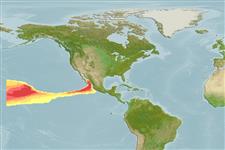Classification / Names
Nomi Comuni | Sinonimi | Catalog of Fishes(Genere, Specie) | ITIS | CoL | WoRMS | Cloffa
>
Stomiiformes (Lightfishes and dragonfishes) >
Stomiidae (Barbeled dragonfishes) > Melanostomiinae
Etymology: Eustomias: Greek, eu = good + Greek, stoma = mouth (Ref. 45335); curtatus: Named for its dimunitive projection of the bulb and the short barbel..
Environment: milieu / climate zone / depth range / distribution range
Ecologia
marino batipelagico; distribuzione batimetrica 0 - 1000 m (Ref. 11333). Deep-water
Distribuzione
Stati | Aree FAO | Ecosystems | Presenze | Point map | Introduzioni | Faunafri
Eastern Central Pacific: vicinity of Hawaii.
Size / Peso / Age
Maturity: Lm ? range ? - ? cm
Max length : 15.2 cm SL maschio/sesso non determinato; (Ref. 11333); 15.3 cm SL (female)
Short description
Morfologia | Morfometria
Raggi dorsali molli (totale): 25; Raggi anali molli: 40; Vertebre: 68. A single terminal bulb, its length more than twice its width, with a very short or no terminal projection. Bulb and projection combined 0.4-1.6% SL. Barbel 35-57% SL. Axis of stem moderately pigmented proximally, usually becoming lighter distally. External chevron-shaped or roundish striated areas unpigmented, becoming closely spaced distally. Spherical to ovoid inclusions present in distal half of stem, small and widely spaced proximally, becoming fairly crowded distally, difficult to discern in specimens smaller than about 9 cm SL. Middorsal paired spots between occiput and dorsal-fin origin 8, sometimes 7 or 9 (Ref. 11333).
Mesopelagic (Ref. 58302).
Life cycle and mating behavior
Maturità | Riproduzione | Deposizione | Uova | Fecundity | Larve
Gibbs, R.H. Jr., T.A. Clarke and J.R. Gomon, 1983. Taxonomy and distribution of the stomioid fish genus Eustomias (Melanostomiidae), I: subgenus Nominostomias. Smithson. Contrib. Zool. 380:139 p. (Ref. 11333)
IUCN Red List Status (Ref. 130435)
Threat to humans
Harmless
Human uses
Informazioni ulteriori
Nomi ComuniSinonimiMetabolismoPredatoriEcotossicologiaRiproduzioneMaturitàDeposizioneSpawning aggregationFecundityUovaEgg development
Age/SizeAccrescimentoLength-weightLength-lengthLength-frequenciesMorfometriaMorfologiaLarveDinamica popolazioni larvaliReclutamentoAbbondanzaBRUVS
BibliografiaAcquacolturaProfilo di acquacolturaVarietàGeneticaElectrophoresesEreditarietàMalattieElaborazioneNutrientsMass conversion
CollaboratoriImmaginiStamps, Coins Misc.SuoniCiguateraVelocitàModalità di nuotoArea branchialeOtolithsCervelliVista
Strumenti
Special reports
Download XML
Fonti Internet
Estimates based on models
Preferred temperature (Ref.
123201): 5.5 - 13.6, mean 7.8 °C (based on 6 cells).
Phylogenetic diversity index (Ref.
82804): PD
50 = 0.5000 [Uniqueness, from 0.5 = low to 2.0 = high].
Bayesian length-weight: a=0.00302 (0.00117 - 0.00783), b=3.12 (2.89 - 3.35), in cm total length, based on LWR estimates for this (Sub)family-body shape (Ref.
93245).
Trophic level (Ref.
69278): 4.3 ±0.8 se; based on size and trophs of closest relatives
Resilienza (Ref.
120179): Medio, tempo minimo di raddoppiamento della popolazione 1.4 - 4.4 anni (Assuming tmax>3).
Fishing Vulnerability (Ref.
59153): Low vulnerability (10 of 100).
